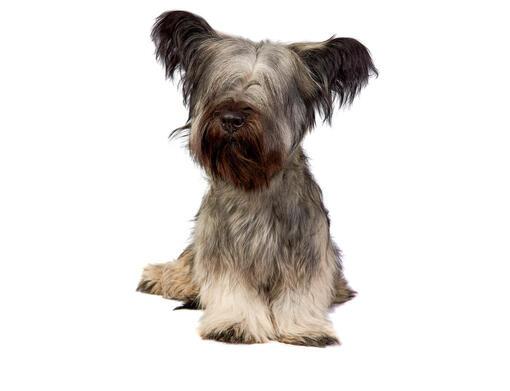
Fiercely loyal and affectionate, the Skye Terrier thrives as a family companion. An elegant medium-sized dog with short legs and a large head, the Skye Terrier was originally bred in the 1600s on the Isle of Skye off the west coast of Scotland. One of the oldest and rarest terrier breeds, the Skye Terrier is friendly with those he knows and cautious around strangers. The breed needs regular exercise, and his soft coat requires brushing several times a week plus regular trimming.
DID YOU KNOW? Fourteen years after his master’s death, a Skye Terrier in Edinburgh, Scotland, named “Bobby,” remained loyal, reportedly spending every night watching over his master's grave in Greyfriars Kirkyard. A statue in memorial of “Greyfriars Bobby” was built near the graveyard in 1873.
The need-to-know
- Dog suitable for owners with some experience
- Some training required
- Enjoys gentle walks
- Enjoys walking an hour a day
- Small dog
- Minimum drool
- Requires grooming every other day
- Non hypoallergenic breed
- Chatty and vocal dog
- Guard dog. Barks and alerts
- May require training to live with other pets
- May require training to live with kids
Personality

Devoted to their owners, the Skye Terrier is typically a one-person dog. Strong willed and determined, they can be suspicious of strangers but are devoted to their owner and should be good tempered and cheerful, lively and with a sense of fun.
History and Origins

Country of Origin: Scotland
Originating in the rugged Western Isles off Northern Scotland, the Skye Terrier takes its name from the Isle of Skye, where their tough, tenacious nature and short legs allowed them to go to ground after their quarry. Once Queen Victoria acquired a Skye Terrier in 1842 however, this breed’s popularity as a show-dog and companion increased dramatically, and as a result the breed was altered physically. They became longer, heavier and a more profuse coat was encouraged, but the terrier characteristics, a ‘never say die’ attitude and a strong belief that they are far bigger than reality remains to this day.
Nutrition and Feeding

Small dogs have a fast metabolism, meaning they burn energy at a high rate, although their small stomachs mean that they must eat little and often. Small-breed foods are specifically designed with appropriate levels of key nutrients and smaller kibble sizes to suit smaller mouths. This also encourages chewing and improves digestion.
Exercise

About an hour per day in exercise should keep the Skye Terrier happy. They are however quite inclined towards laziness as long as they’ve had a walk, an opportunity to sniff and some training and games to exercise their mind as well as their body.
Other Information

Health and common issues
The most common health problems encountered in the Skye Terrier is a forelimb bone problem that occurs in growing puppies. Like other breeds with short legs and long spines they are also predisposed to spinal disease. The breed club monitor the health of the breed carefully and should be contacted for the most up-to-date information and details of any DNA or additional testing they recommend. Breed Clubs can be found on the Kennel Club website.
Space requirements
Although on paper this appears a small dog, due to their length, weight and amount of coat, they would be better with more space and limited stairs. Room for grooming and dealing with a wet dog after walks or baths is important, and a secure garden with a fence that cannot be squeezed through or dug under essential. The Skye Terrier can live anywhere within reason, however they are a vocal breed inclined to guarding and alerting to sounds, so inner-city living may prove too stressful for both the dog and your neighbours.
Training skye terrier
The Skye Terrier is more than capable of achieving a good basic level of training, if you understand how to motivate and engage them, however this isn’t a dog who demands hours of mental stimulation. Positive reinforcement training using food and toys will get the best out of this dog. Focus on a good recall and socialisation around children, other pets and livestock. This is a heavily coated breed and so early work on teaching a Skye Terrier to stand for grooming, bathing and drying is essential.
Best family dog breeds
With training and sensible older children, the Skye Terrier makes a good family pet, as long as everyone understands a terrier’s nature. Not ideal with smaller children due to the Skye Terriers long back and short legs which put them at higher risk of injury should a child trip or accidentally fall on the dog. While many dogs are traditionally thought of as being good with children, all dogs and children need to be taught to get on with and respect each other, and be safe together. Even so, dogs and young children should never be left alone together and adults should supervise all interactions between them.
Did you know?
- Most people have heard of Greyfriars Bobby, a Skye Terrier famous for his dedication to his owner, so much so that he sat at his owners grave-side in Greyfriars Churchyard for 14 years until he died of old age. Most people don’t know that the character ‘Dougal’ from the 1960’s children’s television show ‘The Magic Roundabout’ was (probably) a drop-eared Skye Terrier.
- Sir Edwin Landseer (a painter and sculptor best known for the lion sculptures in Trafalgar Square) created a great many paintings of Skye Terriers and his work helped to popularise the breed during the Victorian era.
- Skye Terriers were incredibly popular with the aristocracy in Victorian England and apparently duchesses would be ashamed to be seen walking without one in the park.
- It’s thought that Mary, Queen of Scots had a Skye Terrier (though some believe it was a Maltese) and when she was beheaded, her loyal dog hid beneath her petticoat.